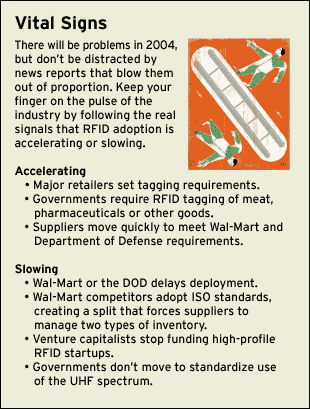Every January for the past five years, someone has predicted that radio-frequency identification technology will finally take off. And invariably, that person has been wrong. This year’s prognosticator may feel assured that the time for widespread RFID adoption has finally arrived, now that Wal-Mart and the U.S. Department of Defense have asked their suppliers to start tagging pallets and cases in 2005. Don’t bet on it.
Given all the hype and hoopla and genuine progress in 2003, it’s not surprising that expectations have been raised for RFID technology and what it can do for businesses. But the industry is still too immature to be able to meet them.
For sure, there will be good news. Several more large retailers will likely follow the lead of Wal-Mart and Tesco and announce that they, too, are going to track pallets and cases with RFID tags. And there will be some high-profile investments by venture capitalists in RFID startups. But there will be plenty of bad news. Here’s why.
EPC specs are evolving
The Electronic Product Code developed by the Auto-ID Center has been handed off to EPCglobal, a joint venture set up by the Uniform Code Council and EAN International to commercialize the technology. But the organization’s efforts will be slow to produce results at first because EPC specifications aren’t complete. EPCglobal committees are working on mapping EPC numbers to Global Trade Item Numbers and other identification schemes, such as the DOD’s Unique Identification number.
EPCglobal’s Hardware Action Group is working on a second version of the Class 1 protocol. This is not a minor upgrade. Class 1, Gen2 will be a complete overhaul that aims to achieve a global standard (see “The Standard Problem,” page 8). It will take time for EPC specifications to mature.
EPCglobal needs time
Getting millions of companies in different countries and different industries to invest millions in an unproven system, such as the EPC network, is quite a challenge. EPCglobal has set up an implementation task force to resolve the issues mentioned above, but inevitably, political squabbling will slow progress. Different industries will have different needs, and some companies will put their business needs above the good of the organization. A company that’s behind leading adopters, for instance, might try to delay decisions as it tries to catch up.
Another issue is the makeup of the organization. EPCglobal will not be a single global entity; it will have local chapters around the world. That’s a huge long-term advantage for EPC technology because once the technology is ready, it will have an infrastructure to support global adoption already in place. But in the short term, each chapter needs to be educated and encouraged to put resources into promoting EPC adoption. This will take time, money, organizational skills and leadership. Some chapters will be more successful than others in pulling all these elements together.
Pilots will crash
Implementing any new technology isn’t easy. A successful RFID project requires bringing together employees from different departments, including IT, operations and supply chain. This team has to agree on a project that makes sense, build the business case, change their business processes, educate the people affected and then choose the right technology and partners. Some companies will launch high-profile pilots without doing all their homework. And they will fail.
None of these issues alone or taken together are serious enough to deal RFID adoption a fatal blow, but the bad news will be amplified for several reasons. Many companies don’t want to be forced by Wal-Mart, the DOD or anyone else to adopt this technology now. Their businesses are struggling with the slow economy, and they don’t have a lot of money to throw at a new technology. Many CEOs will seize on short-term problems so they have an excuse to delay adoption of RFID for several more years, and they will take every opportunity to justify their decisions.
There are also many RFID vendors that don’t make EPC products. They’ll be eager to play up the bad news because if the market adopts EPC quickly, they could be hurt in the short term. The analysts who steadfastly said that the EPC vision was unrealistic would rather not admit they were wrong, so they’ll make minor stumbles seem like EPC’s death knell. And, of course, some activists will continue to hype RFID as the end of privacy as we know it.
As all these problems will get reported by journalists eager for a new angle on RFID, companies that want to remain competitive will have to analyze the news carefully (see “Vital Signs,” above). The real picture probably won’t become clear until the second half of 2005. That’s when Wal-Mart and the Department of Defense, along with some of their more advanced suppliers, will begin to demonstrate whether RFID—or, more specifically, EPC—technology really delivers business benefits. Which means that 2006 could be the year RFID really takes off.



